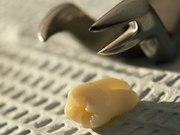In an ex vivo setting, mercury is released from amalgam fillings after exposure to 7.0-T MRI
WEDNESDAY, June 27, 2018 (HealthDay News) — Mercury is released from amalgam fillings after exposure to 7.0 Tesla (T) magnetic resonance imaging (MRI), according to a study published online June 26 in Radiology.
Selmi Yilmaz, Ph.D., from Akdeniz University and M. Zahit Adisen, Ph.D., from Kirikkale University, both in Turkey, examined 60 caries-free molar or premolar teeth that had been extracted for clinical indications to assess ex vivo mercury release from dental amalgam after MRI. In each tooth, two-sided cavities were opened and amalgam fillings were applied. After nine days, two groups of 20 teeth were randomly selected and placed in 20 mL artificial saliva, and then immediately exposed to 20 minutes of MRI at either 1.5 or 7.0 T. A control group of teeth was placed in artificial saliva without undergoing MRI. After 24 hours, the saliva was analyzed for mercury content using inductively coupled plasma mass spectrometry.
The researchers found that the mean mercury content of the artificial saliva was 673 µg/L ± 179 in the 7.0-T MRI group, 172 µg/L ± 60 in the 1.5-T MRI group, and 141 µg/L ± 152 in the control group. The mercury content was significantly greater in the 7.0-T MRI groups than in the 1.5-T MRI and control group. No statistically significant difference was seen in mercury content between the 1.5-T and control groups.
“In an ex vivo setting, mercury was released from amalgam fillings after exposure to 7.0-T MRI but not 1.5-T MRI,” the authors write.
Copyright © 2018 HealthDay. All rights reserved.








